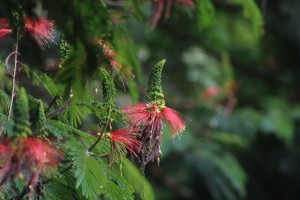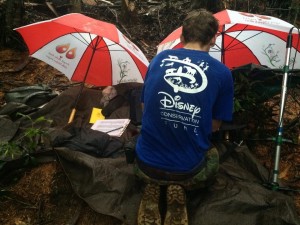For those of you who follow our Instagram ( @littlefireface ), you may have recently seen a post about undergraduate researcher Dan Geerah and myself conducting something we like to call “all-night tree follows”. This literally consists of us spending an entire night from sundown to sunrise, sitting outside a single tree and recording all species’ interactions with it – everything, from mammals to moths.

Despite out excitement to trial this non-traditional method, I had made the rookie mistake of getting carried away with day work, not allotting time to nap during the day. Completing the full-night follow would mean 48 hours without sleep (sorry if you’re reading this, Ma!). But we went out regardless, and just made sure to bring the essential equipment: 2 canteens of Yorkshire tea. Then there were the other non-essentials, such as a rain tarp, umbrellas, binoculars, notebooks, vocalization equipment, camera and video cameras, dinner and chocolate…

Our tree follows focus on fairy dusters (Calliandra calothrysus). If you haven’t heard me go on about this species before, it is a legume that produces magnificent bright red flowers. These flowers produce a nectar that is a regular food resource for lorises, and based on our literature review, possibly bats as well. While we both study lorises, a large portion of Dan’s research is also recording bat vocalizations and abundance, while I am additionally looking at pollinators in the Cipaganti area. These follows allow us to identify everything which feeds, forages and potentially pollinates the fairy dusters in this area. While Dan does his bat surveys, he can also identify specific bat species that forage on the Calliandra, just by ultrasonic vocalizations.
Sitting in a single space in the forest at night is amazingly peaceful, and you become much more tuned in to the sounds of all the insects and animals. While the night started off strong, the Zen atmosphere and my lack of sleep quickly joined forces, and I was resorting to our tea supply earlier than intended. It took the patience of Dan to hold conversation and keep me awake with random facts and alternating staring at our focal tree. Fortunately, it wasn’t long before we saw some exciting things that woke me up. Our immobile camp set-up was causing all sorts of shy animals to overlook our presence. We were located next to a bamboo patch that faced the fairy dusters, and had a close up view of a Common-palm civet, hopping up the bamboo. While I’ve seen civets many times in the forest, it has always been at a distance. From a new perspective, I can assure you, their locomotion is both peculiar and captivating! About 1-hour later, a Leopard cat pounced out at something in the tea plantation just at our feet. It wasn’t until missing its prey that it even noticed us (and then proceeded to stalk Dan, while he tried to get some photographs of the stars).
All in all, our tree follow was a success, and definitely a learning curve! Sometimes it’s nice to just sit still in the forest, observing and listening to everything that is going on around you. But most importantly, you would appreciate it even more if you’ve had some decent sleep!
- Katie Reinhardt, PhD Researcher
